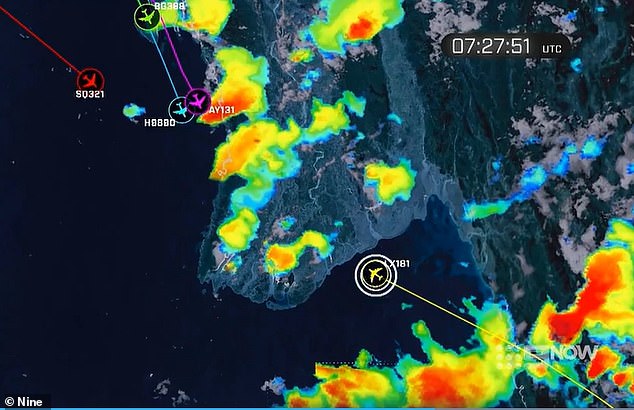A former Australian Air Force and Qantas pilot with more than three decades of experience flying passenger jets has shared his theory about what happened on board a fatal Singapore Airlines flight.
Retired pilot Richard Woodward believes Singapore flight SQ321 from London to Singapore ran directly into a thunderstorm on May 21, 2024.
Flight radar images of the accident show that other aircraft flying over Myanmar (where Flight SQ321 encountered catastrophic turbulence, claiming one life and injuring more than 100) avoided the increasing storm activity.
However, SQ321 stayed true to its predicted path and headed directly toward the center of the storm.
Mr Woodward called the decision “a terrible miscalculation”.
Looking at the radar images, he said: 60 minutes On Sunday: ‘They are showing (storm) cells developing across southern Myanmar, so there is a large area of thunderstorm activity.
“Of course, you’d either go along the coast and circle around or you’d push your way through the cells, but you certainly wouldn’t try to fly downwind because that’s where the weather blows.”
Mr Woodward said the passengers jumped from a “massive updraft into a massive downdraft”, causing them to crash into the overhead compartments of the cabin.
Retired pilot Richard Woodward (pictured) on Sunday shared his theory that Singapore flight SQ321 from London to Singapore ran directly into a thunderstorm on May 21, 2024.

Flight radar images (above) of the accident show that other aircraft flying over Myanmar avoided the thunderstorm activity. However, SQ321 (shown in red) stayed true to its intended path and headed straight for the centre of the cell.
“The plane effectively drops 178 feet, which puts everyone not strapped into the roof at the back of the plane and they are trapped there as the plane falls,” he said.
‘But within a couple of seconds it goes back to positive G-force and you slam into whatever’s beneath you (seat backs, seat floors, whatever), boom! It’s all over in 4.6 seconds.
“It is unheard of that such damage could have occurred in such a time.”
Mr Woodward believes the pilots may have misjudged the strength of the storm system and attempted to fly over it.
“I think in their view this is a benign area and they think they can just fly over it and move on,” he said.
Many media outlets initially reported that the flight had been subject to “clear air turbulence,” a rare phenomenon in which strong turbulence suddenly hits an aircraft with little visual warning.
However, Mr Woodward said clear-air turbulence was “very rare” in tropical areas such as Myanmar, and the pilots of SQ321 should have been able to see lightning from the storm.

Kerry Jordan’s spine was broken when she was pushed from her seat into the upper cabin (pictured, Ms Jordan with her partner, Keith Davis)
“The crew would be seeing all these cells developing on radar and assessing whether they need to go around them or not, but it appears from the fact that they’re not deviating that they think they can get through,” he said.
“…You can’t sit in the front of a big passenger plane unless you’ve gone through years and years of training, but we don’t know what was going on in the flight deck and we don’t know what they were looking at.”
If the pilots made the decision to fly through the storm cell, it was a choice that changed South Australian passenger Kerry Jordan’s life forever.
Ms Jordan’s spine was broken when she was pushed from her seat into the upper cabin.
The horrific injury left Ms Jordan, a dance teacher, paralysed from the waist down and wheelchair-bound, likely for the rest of her life.
She has been hospitalized since the devastating accident and will not be able to return to her former home due to access issues.
Ms Jordan and her partner, Keith Davis, have been offered just $75,000 by Singapore Airlines.
Asked what he thought caused the crash, Mr Davis said: “Someone took their eyes off the dial… what else can I think of?
‘If you put yourself in a situation that could have been avoided with a diversion… when you hear information that other flights that are in the air at the same time in the same region are doing exactly that, it’s just unbelievable.
“The data doesn’t lie.”

Ms Jordan (pictured), a dance teacher, was left paralysed from the waist down and bound to a wheelchair, likely for the rest of her life.
A Singapore Airlines spokesman said the airline “apologizes to all passengers for the traumatic experience on board SQ321.”
“We are discussing compensation details directly with affected passengers or their designated representatives,” they said.
‘Singapore Airlines is committed to providing all necessary support and assistance to passengers on board SQ321.’

